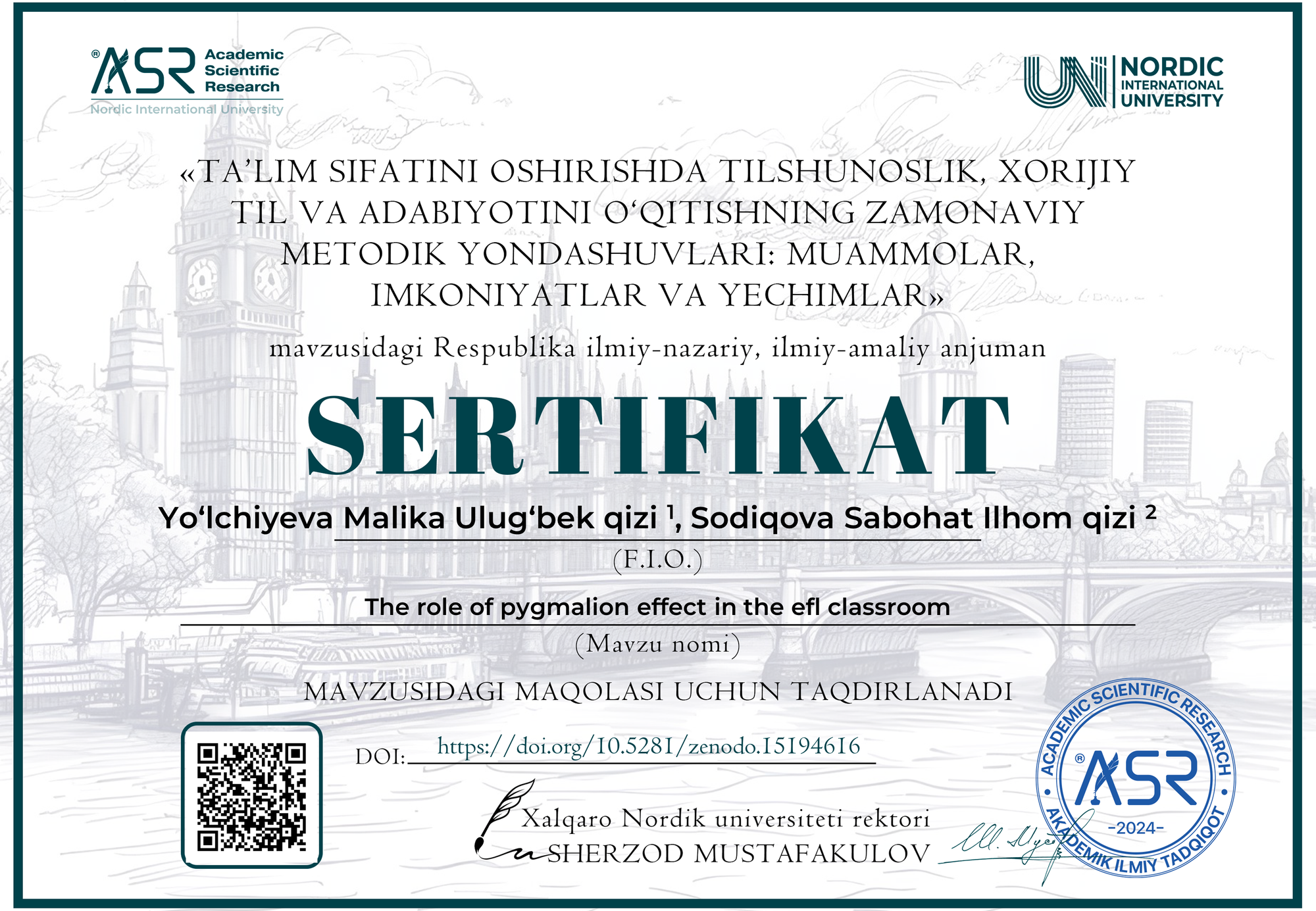Yo‘lchiyeva Malika Ulug‘bek qizi 1, Sodiqova Sabohat Ilhom qizi 2

DOI: https://doi.org/10.5281/zenodo.15194616
Google scholar: https://scholar.google.com/scholar?hl=ru&as_sdt=0%2C5&q=%22THE+ROLE+OF+PYGMALION+EFFECT+IN+THE+EFL+CLASSROOM%22&btnG=
Zenodo community: https://zenodo.org/records/15194616
Nordic_press journal: https://research.nordicuniversity.org/index.php/nordic/article/view/2326
MAQOLANI YUKLAB OLISH
SERTIFIKATNI YUKLAB OLISH
REVIEW:
The paper "The Role of Pygmalion Effect in the EFL Classroom" provides an insightful examination of how teacher expectations influence the performance and motivation of students in English as a Foreign Language (EFL) contexts. The authors effectively explore the Pygmalion effect—an idea that posits that higher expectations from educators lead to better student performance—and its application in EFL classrooms.
The paper starts with a clear and concise introduction to the Pygmalion effect, referencing the seminal work of Rosenthal and Jacobson (1968). The authors establish that teacher expectations, both positive and negative, can significantly impact students' academic outcomes. In an EFL classroom, this effect is particularly crucial because language learning is not only a cognitive process but also a motivational one. The authors emphasize that when teachers have high expectations, they tend to foster an environment conducive to student success by boosting their self-esteem, motivation, and confidence.
A strength of the paper is its integration of theoretical perspectives from well-known educators like Brophy (1986), who argue that teacher expectations play a pivotal role in shaping student behavior and achievement. Additionally, the authors address the challenges faced by teachers, particularly in multicultural classrooms, where biases based on cultural and socio-economic backgrounds may affect their expectations. This is an important aspect to consider, as it underscores the complexity of applying the Pygmalion effect universally without accounting for individual differences.
The paper also includes a survey conducted with 15 students in a multicultural EFL classroom. The survey results are particularly revealing. A significant 80% of students reported that their teacher expects them to do well, and 60% felt very confident about their language abilities in class. These findings suggest that teacher expectations can directly influence students' self-perception and motivation. Interestingly, only 13% of students reported feeling discouraged by their teacher's comments, which further underscores the positive influence of teacher expectations in this context.
However, the study also highlights a potential issue: teacher bias. As Rimm-Kaufman et al. (2002) point out, teachers may unknowingly have differential expectations based on cultural or socioeconomic factors. This is a valid concern, as bias can undermine the Pygmalion effect, leading to unequal opportunities for students. The authors rightly suggest that professional development for teachers is essential to mitigate such biases and create an equitable learning environment for all students.
The conclusion of the paper reinforces the importance of positive teacher expectations in enhancing student achievement. It also calls for more research into how the Pygmalion effect can be leveraged in various educational settings to improve teaching practices. The authors suggest that professional training focused on expectation management could be key to addressing issues related to bias and fostering a more inclusive and supportive learning environment.
In terms of areas for improvement, the paper could have included more detailed discussions on how teachers can practically apply the Pygmalion effect in their classrooms. While the paper touches on some strategies, such as creating a supportive classroom atmosphere, it would have been helpful to see more concrete examples or case studies of successful implementation. Additionally, a larger sample size for the survey could have provided more robust insights into the Pygmalion effect in diverse educational contexts.
Overall, this paper provides valuable insights into the role of teacher expectations in the EFL classroom and the broader implications for educational psychology. It highlights the need for educators to be aware of their expectations and how these can influence student motivation and performance. The call for professional development and further research into the Pygmalion effect is timely and essential for promoting effective and equitable teaching practices in multicultural settings.



